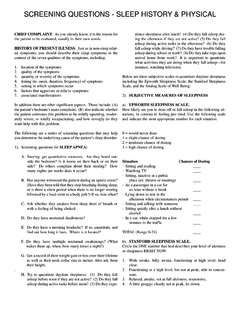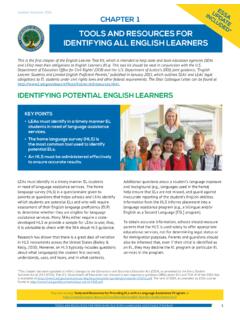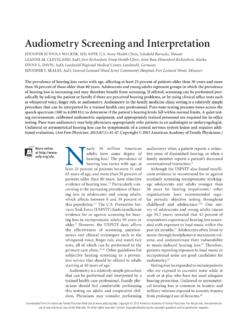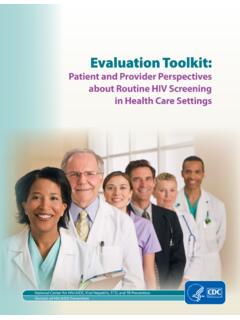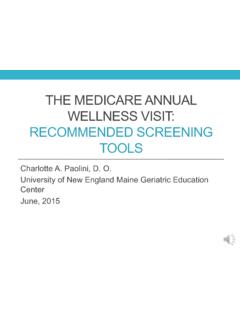Transcription of Adult Human Trafficking Screening Tool and Guide
1 1 Adult Human Trafficking Screening Tool and Guide A Guide for training public health, behavioral health, health care, and social work professionals who wish to use trauma-informed and survivor-informed practices to assess Adult clients and patients for Human Trafficking victimization or risk of potential Trafficking victimization. January 2018 2 Toolkit ACKNOWLEDGMENTS This publication was funded by the Department of Health and Human Services (HHS), Administration for Children and Families, Office on Trafficking in Persons (OTIP), contract number HHSP233201500071I/HHSP23337011T, and produced by the National Human Trafficking Training and Technical Assistance Center (NHTTAC), which is managed by ICF.
2 The content of this document are those of the authors and do not necessarily represent the views of HHS. Special acknowledgments are due to the primary authors of this Toolkit: Wendy Macias-Konstantopoulos, , Medical and Executive Director, Massachusetts General Freedom Clinic for Trafficking Survivors; Director, Human Trafficking Initiative; Massachusetts General Hospital, Harvard Medical School Julie Owens Expert Consultant, Violence Against Women and Trauma, Julie Owens Consulting, LLC We wish to acknowledge and extend our thanks to our NHTTAC Advisory Group.
3 Kenneth Chuang, Subject Matter Expert, Refugee Trauma Program, UCLA Medical School Bukola Oriola Subject Matter Expert, Member of the Advisory Council on Human Trafficking Virginia Perez-Ortega Subject Matter Expert, Victim Advocate, Independent Consultant Dawn Schiller Subject Matter Expert, Survivor Leader, Consultant Trainer Marq Taylor Subject Matter Expert, Survivor Leader, The BUDDY House, Inc. Special thanks are also extended to the following individuals who shared information and helped to inform this report: Maria Jose Fletcher, Vida Legal Assistance, Inc.
4 Annie Lewis-O'Connor, , , Women s Clinic, Brigham and Women s Hospital Rebecca J. Macy, , , School of Social Work, University of North Carolina at Chapel Hill 3 Toolkit TABLE OF CONTENTS Acknowledgments .. 2 Executive Summary .. 4 Methodology .. 5 Elements of Administering a Trauma-Informed Screening Tool .. 6 Before Using This Toolkit .. 6 1. Take Human Trafficking Training .. 62. Establish an Internal Response Protocol .. 73. Implement an Information and Referral Network .. 7 Administering the Screening Tool.
5 7 1. Establish a Relationship .. 72. Indicators of Trafficking ..113. Information and Referral Process ..114. Safety Planning ..12A. Assess the Current Risk ..12 B. Strategies to Reduce the Threat of Harm ..13 C. Options for Responding When Safety Is Threatened ..13 The Adult Human Trafficking Screening Tool ..15 Agency Considerations to Effectively Use This Screening Tool ..18 Mandatory Reporting ..18 Recordkeeping ..19 Staff Training ..20 Cultural and Linguistic Competency, Ethical, and Safety Considerations.
6 21 Language Access ..22 Cultural Responsiveness ..23 Privacy and Confidentiality ..24 Other Screening Tools ..25 Conclusion ..26 Recommendations ..27 Evaluate and Validate ..27 Develop an Accompanying Training ..27 Appendix A: Screening Adult Victims or Those at Risk of Experiencing Trafficking ..28 Appendix B: Indicators of Human Trafficking ..31 Appendix C: Screening Flowchart for Adults at Risk for Human Trafficking ..32 Appendix D: Literature Review ..33 4 Toolkit EXECUTIVE SUMMARY The prevailing framework to screen for Adult Human Trafficking has historically been rooted in a criminal justice approach focused on punishing and prosecuting traffickers, mostly Screening for victims intersecting with law enforcement institutions.
7 A public health approach recognizes that victims of Trafficking intersect with multiple systems of care, including health and Human services, educational settings, and community and faith-based organizations that can provide assistance to victims and their families. A public health approach also emphasizes Screening to prevent potential Trafficking victimization or re-victimization, especially for individuals who are at disproportionate risk of Human Trafficking . The Adult Human Trafficking Screening Tool (AHTST) is designed for use across the various behavioral health, health care, social service and public health settings.
8 This Toolkit provides a Screening tool to use in identifying adults who you suspect may have experienced sex or labor Trafficking . While this tool is not yet validated, it has been developed based on the latest research and best practices in Screening . The goals of this Toolkit are to help you: The AHTST was designed for use by behavioral health, health care, social work, and public health professionals. Contact NHTTAC to receive training to effectively use this toolkit at Recognize the emotional, behavioral, and physical signs oftrafficking (commonly known as red flags ) Respond appropriately and sensitively through Screening toassess the particular needs of your client or patient Make appropriate referrals for servicesThis Toolkit also provides ways in which you can use a conversational Screening session to effectively identify people who may have been trafficked and those vulnerable to Trafficking .
9 To effectively use this tool, professionals in these areas should receive the education and training necessary to consistently recognize signs and symptoms of adults with a history of or vulnerability to Trafficking . This Toolkit includes: Elements of a trauma-informed Screening tool Considerations for administering the tool Agency practices to be implemented before use of the Screening tool Ethical and safety considerations Steps toward appropriate and meaningful referrals 5 Toolkit The AHTST is a survivor-centered, trauma-informed, and culturally appropriate intervention tool that draws from evidence-based practices and lessons learned from available Screening instruments used by public health professionals in the fields of Human Trafficking .
10 Domestic violence, sexual assault, and HIV Screening . It reflects promising practices for inclusivity when Screening individuals from diverse backgrounds, including foreign nationals, racial/ethnic minorities, gender and sexual minorities, and other underserved populations. The eight Screening questions that make up the AHTST are designed to be short, minimally invasive, and closed-ended. The overall aim of the AHTST is to obtain only the basic information needed to identify an Adult currently or at risk of being trafficked so that you can offer appropriate services, including referrals and services.

